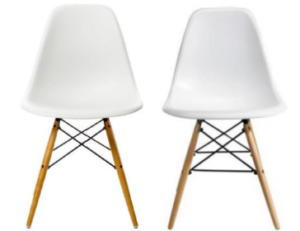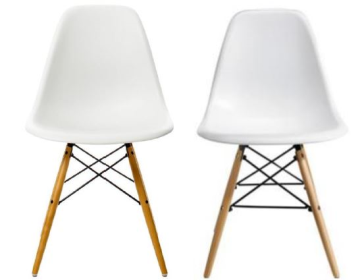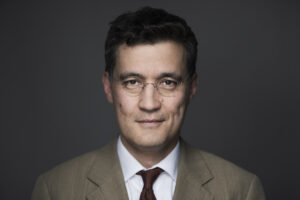Copyright protection in the EU has significantly expanded for works of applied art, regardless of the country of origin or the author’s nationality. This follows from a landmark decision of the Court of Justice of the European Union’s (CJEU) in the Kwantum case on October 24, 2024. The decision sweeps aside prior treaty-based limitations, extending EU copyright protection for objects designed in non-EU countries like the US and UK. This practice note outlines the case’s background, its legal context, and practical takeaways.
Background: Kwantum v. Vitra
The Kwantum case stems from a copyright dispute winding through the Dutch courts since 2014. Swiss-based furniture manufacturer Vitra alleged that Dutch retailer Kwantum infringed on the copyright of its ‘Dining Sidechair Wood’ (DSW) — designed in 1950 by U.S. nationals Charles and Ray Eames for a competition in the Museum of Modern Art in New York. Kwantum sold its ‘Paris’ chair in Belgium and the Netherlands, prompting claims of infringement.

DSW – Vitra Paris – Kwantum
Source: Hague Court of Appeal, decision 14 July 2020, (ECLI:NL:GDHA:2020:1218)
Kwantum primarily relied on the ‘reciprocity exception’ (more below) provided in the Berne Convention, under which copyright protection can be denied if such protection is absent in the country-of-origin. Applying Dutch case law, the lower courts tested copyright eligibility of this particular chair design under US law. The Hague Court of Appeal held the DSW chair as an original work under § 102(a) of the US Copyright Act and found against Kwantum. The Dutch Supreme Court (Hoge Raad der Nederlanden) subsequently referred questions to the CJEU, asking whether EU law permits reliance on Berne’s reciprocity exception for works of applied art originating outside the EU.
The Berne Convention: Reciprocity Exception and Applied Art
Berne Convention
The Berne Convention mandates that member states provide a minimum standard of copyright protection to works originating in other member countries, granting foreign authors the same rights as domestic ones. However, a key exception applies to works of applied art.
The Reciprocity Exception
Under Article 2(7) of the Berne Convention, countries may deny copyright protection to works of applied art if such protection is not granted in the country of origin. Applied art refers to utilitarian objects designed for industrial or functional use, distinct from artistic works.
For decades, the Netherlands and other EU countries relied on this exception to deny copyright protection to utilitarian designs originating in countries with restrictive copyright laws for such works (e.g., the US and UK). Accordingly, in Dutch case-law, products like toys, apparel, furniture, and vehicles have run up against the exception and often been excluded from copyright protection.
The Kwantum decision upends this precedent, expanding harmonized protection for works of applied art across the EU, regardless of origin.
The Kwantum Decision: Harmonization of Copyright for Applied Art
The CJEU has previously not hesitated to harmonize material concepts of copyright law, mainly based on the Information Society Directive of 22 May 2001 (“InfoSoc Directive“, 2001/29/EC). In the Kwantum decision the court takes the same approach. Key aspects of the decision include:
- Originality Standard Applicable
The CJEU determines that once an item of applied art marketed in an EU Member State can be classified as a ‘work’ protected by copyright, it falls within the scope of EU law. Under harmonized EU law it is sufficient that there is a –definable– work that is original, in the sense that it is the author’s own intellectual creation (Infopaq, C‑5/08). This applies to artistic works and utilitarian products alike, as was confirmed in cases that concerned a jeans pocket design (Cofemel, C-683/17) and the design of a folding bicycle (Brompton, C-833/18).
- Reciprocity fragments EU Harmonization
The court rules that allowing Member States to apply the reciprocity exception would undermine the aim of harmonization of copyright law in the internal market. Under the reciprocity exception, works of applied art originating from third countries could be treated differently in different EU Member States, given the various applicable national approaches. The court finds that because the EU did not legislate with regard to reciprocity exception, contrary to other subjects overlapping the Berne Convention (i.e. the Copyright Term Directive and Resale Rights Directive), harmonized copyright protection for works provided by the InfoSoc Directive should apply regardless of the country of origin of the work or the nationality of the author.
- Copyright is a Fundamental Right
Copyright is protected under Article 17(2) of the Charter of Fundamental Rights of the EU. As such, limitations must be provided for by law and respect the essence of the rights and freedoms protected. It is for the EU legislature alone, and not for national legislatures, to determine whether the grant of that copyright in the EU should be limited in respect of works or authors originating from a third country (Raap, C-265/19).
Practical Implications: Eight Takeaways from Kwantum
- Worldwide impact on EU copyright protection
Copyright protection in the EU market is broadened for non-EU works of applied art, in particular to include designs and authors that previously received little or no protection due to a lack of copyright in their countries of origin such as the US or UK. - Unified Originality Test
EU courts will have to apply a harmonized originality test, irrespective of national or non-EU standards. The US “separability test” or, in the UK, the category of works of artistic craftsmanship are not relevant to gaining copyright protection in the EU. The DSW-chair, a famous design, will likely pass the originality test. Likewise, the WaterRower-case offers an example of a UK designed product likely to be protected by copyright in the EU, but not in the UK, as was recently decided (11 November 2024 [2024] EWHC 2806 (IPEC)). - National Disparities Remain
While harmonized in principle, in practice national traditions persist with regard to copyright protection of works of applied art. Italian or German courts are often perceived as stricter in this respect then –say– Dutch courts. - Extended Protection
The term of copyright protection mandated by EU law generally spans the life of the author plus 70 years. This is an advantage over alternative but shorter-term design protections. - Retroactive Effect and State Liability
The Infosoc Directive was implemented in EU-countries by December of 2002, opening up retroactive implications. In cases that wrongly denied protection under the reciprocity exception, state liability claims in theory may exist (Köbler, C-224/01). However, such claims face steep procedural hurdles.
- Re-examination of Past Cases
Previous disputes, particularly if settled informally, undecided or only decided provisionally may be revisited for potential appeals or reopening.
- Review of License Agreements
Licensing agreements should be checked to see if they sufficiently take into account new and/or extended exclusive rights arising from extended copyright protection.
- Policy Toward EU Copyright Harmonization
Many legal commentators and parties weighing in at the CJEU expressed support for a ruling that, in effect, EU-law has not harmonized copyright protection for non-EU works of applied art. The CJEU decision rejects that more cautious approach. It again signals an intent to drive further harmonization of copyright law and not wait for legislative initiative.
This practice note was prepared by Arnout Gieske, attorney at law, Van Diepen Van der Kroef. For further inquiries on product design protection or intellectual property law, please contact us.

